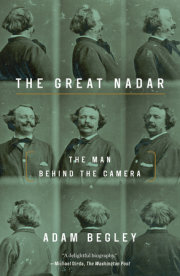***This excerpt is from an advance uncorrected copy proof***
Copyright © 2017 Adam Begley
Chapter 1 NADAR ALOFT
The Year is 1860, or possible 1864. The place is a four-story building on the south side of the boulevard des Capucines, between La Madeleine and the Opera, strolling distance from the epicenter of fashionable Paris. If you look up,
you'll see near the top of the facade of number 35 a name in giant script: Nadar, signed with a flourish in red glass tubing, the letters ten feet high, the whole trademark fifty feet long. At night the sign is gaslit, a garish crimson beacon advertising the studio of the most famous photographer in France. Nadar is a celebrity, renowned not only for his portraits of eminent contemporaries but also for his caricatures, his writings, his radical politics, and his daredevil exploits as a balloonist. Today he will be calling upon several of his talents at once: he is at work on a portrait of himself as an aeronaut, a task that combines self-exposure with self-promotion and self-caricature. His motives, like almost all motives, are mixed. The photograph will advertise his art, promote the cause of human flight- the cause closest to his heart (at the moment)- and serve a specific commercial purpose: generate publicity for a memoir of his most notorious ballooning adventure. But he's chronically incapable of suppressing the artistic ambition that has shaped his photographic career- that is, the urge to capture in every portrait an intimate and compelling psychological likeness. This photo will be a triumph.
The preparation is elaborate. A balloon gondola, a wicker basket about the size of a steamer trunk, is draped in paisley fabric and suspended from the steel rafters of the studio’s glass ceiling. Equipped for flight, complete with grapnel anchor hooked to the side, the gondola must appear to hang from a vast aerostat hovering above, just beyond the frame of the photo. A canvas backdrop of painted clouds gives the illusion that the basket is floating high in the sky—such is the low-tech fakery of early photography. One of Nadar’s assistants attends to the camera, a bulky box mounted on four spidery wooden legs. Covered with a heavy black cloth, the young man peers through the lens at his boss and releases the shutter. Exposure time is a few seconds, so the celebrated aeronaut must hold his pose.
And there he is, aloft, a dapper Nadar in top hat, black coat, and floppy cravat, a jaunty tartan blanket tossed over his shoulder—a dandy of the air. Billowing out from under the brim of the hat, his hair is long, thick, and curly. His mustache, bushy, unkempt, is a reminder of his bohemian youth. Because the photo is black and white, turned sepia with age, we miss the effect of his coloring: hair and mustache are fiery red. Seated in the gondola, elbows out, shoulders square, he’s a solid, capable presence. He radiates composure and serious intent, as though he were charged with making important observations from a great height—in one hand he clutches an impressive pair of binoculars. His purposeful demeanor conveys calm in the face of danger: he is a man on a mission, going it alone.
An uncropped print of the photo comically undercuts that message: at the edge of the image, a few feet from the gondola, another assistant stands idly by, clearly unmoved by his boss’s simulated aerial adventure. The bored look on this employee’s face brings Nadar down to earth with a bump. Our hero is not drifting along with the clouds; the bottom of the basket is barely a yard above the studio floor. His long legs are tucked up inside the gondola; layers of bulky clothing and an assertive pose disguise his gangly frame—he’s about as solid as a broomstick. As for the observations he might be making from on high, he’s in truth very nearsighted, his prominent, widely spaced eyes too weak for reconnaissance. (Look closely, and you can see his spectacles hanging on a ribbon around his neck.) Though he is in fact a brave man, in most other respects the impression he’s pushing to make is false. There’s never been anything calm about Nadar: his close friend Baudelaire singled him out as “the most astonishing expression of vitality.” Exuberant, agitated, impetuous, horrified by boredom and relentlessly and infectiously gregarious, Nadar in his mid-forties is cheerfully scattered, still childlike in his roaring enthusiasms. He means well—but many in his army of companions know that they can’t always rely on him.
Nadar would be the first to laugh at the yawning gap between the pose—the image he plans to project—and the reality captured in the uncropped version of the photo. And yet ballooning is to him quite literally a matter of life and death. He’s determined to put before the public a confidence-inspiring portrait of himself as an intrepid aeronaut: he must appear resolute and in control, a pioneer exploring a new frontier, advancing a sacred cause—what he called le droit au vol (the right to flight).
His pose in another photograph taken the same day is even more intense. Rigidly upright, he stares with wide bright eyes, his fixed gaze almost messianic. Is it the future he sees in the distance, a glorious tomorrow when all mankind will be triumphantly air- borne? (The hallmarks of modernity, he believed, were “photography, electricity, and aeronautics.”) A fellow aeronaut, his wife Ernestine, is in the basket with him, the tartan blanket now wrapped around her slender frame. She looks up at her husband’s face with uneasy devotion, loyal but wary.
Wary with good cause. Ernestine was the only woman among the nine passengers aboard Nadar’s humongous balloon, Le Géant (The Giant), when it crashed spectacularly on Monday, October 19,
1863 —a disaster dramatic enough to earn Nadar newspaper head- lines on both sides of the Atlantic. It’s a tribute to his powers of per- suasion that he was able to convince his young wife to climb back into a balloon basket, even with the basket hanging in the safety of the studio.
Ernestine’s ordeal aboard Le Géant began with an auspicious launch. This was the balloon’s second outing, and a huge crowd, tens of thousands, assembled on the Champ de Mars on Sunday afternoon to watch while it was inflated with more than two hundred thousand cubic feet of gas. Next to it was a balloon of conventional size, a masterstroke on Nadar’s part. When Le Géant rose to its full height of nearly two hundred feet—about twelve stories—it was visible from all over the city; it towered above the smaller balloon. Le Géant’s gondola was a little house made of wicker, a cabin with a half-dozen separate compartments, including kitchen and lavatory. There was a separate compartment for the storage of wine and champagne. On hand to witness the liftoff were Emperor Napoleon III and his guest the king of Greece. If Nadar was gratified by the presence of these potentates, he care- fully disguised his feelings; he was not willing to compromise his radical socialist and republican loyalties, not even for the sake of promoting aeronautics.
As the sun sank in the west, Le Géant rose up magnificent and passed swiftly over the Seine, past the boulevard des Capucines, gaining altitude over Montmartre, newly annexed to the city, and sailing out over the countryside, propelled by the wind in a north- easterly direction, toward Brussels.
Crew and passengers, some of them seasoned aeronauts, some novices, ate dinner on the upper deck, enplein air. During the night, they passed over Belgium and the Netherlands and at dawn found themselves drifting eastward into Germany. Near Hanover, after a pleasant breakfast, also on the upper deck, it was decided that they would attempt a landing.
As they descended, they realized that the wind was now a stiff gale, and their rate of travel dangerously speedy. Worse, the crew couldn’t manage to let enough gas escape to deflate the enormous balloon—nor did they have the means to make it rise again. They had no choice, in other words, but to go through with what promised to be a high-risk landing. The grapnel anchors proved useless: the lines snapped at once. Whipped along by the wind, the partially deflated balloon dragged the gondola across the open countryside at more than twenty miles an hour, the cabin smacking into the ground, rising up once more as high as forty yards, and smashing down again, the terrified passengers hanging on desperately, convinced that violent death was unavoidable.
The balloon—Nadar described it as a “crazed comet”— careened onward for almost half an hour, covering mile after mile, crossing a railway line and narrowly avoiding an oncoming train, splashing through a wide stream, before clattering into a small wood. One by one crew and passengers were thrown clear, until only Nadar and Ernestine remained, clinging to each other and to the leather grips on the wicker railing of the upper deck—then they too were ejected, just before the stand of trees finally halted the balloon’s catastrophic progress.
Incredibly, no one died, although all nine passengers were hurt, just one of them seriously, a young poet who was nearly flayed alive and broke his leg as well. Nadar’s legs were badly bruised and abraded, but he suffered only a hairline fracture. Also severely bruised, Ernestine coughed up alarming quantities of blood but made a rapid and full recovery. A fellow passenger later com- mended her “magnificent sang-froid” during the harrowing half-hour of the epically botched landing.
The weird and wonderful fact is that Nadar had dreamed up his “monster balloon” to demonstrate the limitations of ballooning. He had become convinced of the impossibility of navigating a craft lighter than air. A balloon moves with the air, propelled this way and that by the shifting currents. He wanted to cut through the air. The future, he believed, belonged to “aero-locomotives” such as helicopters and airplanes. Le Géant was built for the express purpose of raising money to fund the construction of a heavier-than- air machine, an aircraft that would “kill” ballooning—preferably before ballooning killed him and his wife and left their young son an orphan.
Part damage control, part devil-may-care defiance, the studio photographs of Nadar the aeronaut coolly in charge of an evidently stable balloon, surveying the scene imperturbably from a prodigious height, are propaganda, part of a strategy that had taken shape even before he launched and crashed Le Géant. The calamitous landing, he knew before the wreckage was cleared, would serve his purpose by exciting public interest. Catastrophe sells—so he commissioned a drawing of the perilous moment when balloon and train seemed on a collision course.
Reproduced in magazines and newspapers around the world, it was the frontispiece of Mémoires du Géant, one of the two books (the other was Le Droit au vol ) he was already hoping to promote when he climbed into a balloon basket in his studio with a top hat on his head.
But it’s the outtake, the uncropped photo with the bored assistant looking on, that achieves Nadar’s artistic ambition. Here the beauty and mad glory of his contradictions come to life. The artist, the publicist, and the adventurer are conspiring, gambling every- thing to will the future into being.
Chapter 2 FELIX
He wasn’t born Nadar, it was a nickname bestowed when he was a very young man, a measure of his popularity with a new group of friends. The nickname
became a badge of his emerging public identity: he used Nadar as a
nom de plume, then as a logo. Protected by court order, the pseudonym was his trademark and became, in the last decades of his long life, his most valuable property.
The name on his birth certificate was Gaspard-Felix Tourna
chon. His parents called him Felix. It would be pleasingly tidy to di vide his private and public life between the two names, but in truth he used them more or less interchangeably from age twenty on. Letters to his mother he invariably signed Felix, but letters to his wife and his brother he sometimes signed Nadar. To colleagues and acquaintances he was almost always Nadar, as he was to friends.
The pseudonym was an emblem of his success, and then of his
celebrity; from early on the name Toumachon had darker associations: it was freighted with a complex family history shadowed by madness and failure, played out against a bloody backdrop of national turmoil. His father, Victor Tournachon, born in Lyon in
1771, scion of a venerable Lyonnais family, is listed on his son's birth certificate as a merchant. More specifically, Victor was a publisher, like his father before him: a printer and a bookseller. If that sounds comfortably bourgeois, settled, and secure, remember that in 1789, when Victor was eighteen, France was turned upside down by the Revolution and that purveyors of the printed word were able to do business only when the political climate and censorship laws allowed it. The Tournachon family was sympathetic to change and negotiated the terrifying and disorienting upheaval of the last de- cade of the eighteenth century—particularly brutal and confused in Lyon—without losing their property or their heads.
A child of the Romantic era, tall and good-looking, Victor was an idealist, faithful to Robespierre’s revolutionary motto “Liberté, Égalité, Fraternité.” He had radical ideas about how society should be reformed, and believed that marriage was incompatible with true love (and liberté). In 1817, when he fell in love with a twenty- four-year-old from a bourgeois family, he stuck to his principles and decamped to Paris with his young sweetheart. The couple lived together—unmarried—at 195, rue Saint-Honoré, willing exiles from the tyranny of social convention. Victor established himself in his old line of work, publishing a best-selling volume, Félicité de Lamennais’s treatise Essay on Indifference in Matters of Religion, and early works by Alexandre Dumas.
Because his parents weren’t married, Félix is listed on the birth certificate as a fils naturel (natural son), a polite French term mean- ing he was illegitimate. His mother is listed as Thérèse Maillet, of independent means. Those means were unfortunately slender: her husband’s principled stand against matrimony meant that her family in Lyon did not offer a dowry. Soon after Félix was born (on April 6, 1820, in the evening, after a difficult delivery), the family moved to 26, rue de Richelieu, a few steps from the Palais- Royal. Six years later—by which time Félix’s father was fifty-five years old, his mother thirty-two, and his baby brother, Adrien, just one—his parents were legally wed. This about-face came as Victor’s once prosperous business began to show alarming signs of decline. The family moved to the Left Bank, to 45, rue Saint- André-des-Arts.
In 1830 Charles X was deposed by the July Revolution, and Louis-Philippe d’Orléans installed as the new king of France. In a bleak climate for booksellers, Victor’s fortunes suffered further collapse; three years later his business lay in ruins. The proximate cause was the spiraling cost of publishing a twenty-five-volume encyclopedia of French law—just the kind of quixotic project guaranteed to appeal to the high-minded but impractical Victor, who lingered in Paris for several years before retreating, in failing health, humbled by his losses and fearful for his sanity, to Lyon. As Félix wrote many years later, “A good man, my father wasn’t born to be in business any more than I was born to be a bishop.” Thérèse and young Adrien accompanied Victor to Lyon, to his brother’s house. Thirteen-year-old Félix stayed behind in the capital, alone.
For several years he had been boarding at a succession of schools in Paris and just outside the city in Versailles. At the time of his parents’ departure, he was lodged at an establishment associated with the Collège Bourbon (now the Lycée Condorcet) run by a kind and forbearing man named Charles Augeron. An inconsistent pupil, Félix had shown flashes of brilliance but was also prone to unexplained lapses. He was playful and sensitive, well liked and generally happy, charming in letters to his parents and in surviving fragments of a youthful diary. Several of his schoolmates became lifelong friends.
At age sixteen, he was already exhibiting signs of a fascination with literary life and celebrity. He wrote to his mother in Lyon asking for Dumas’s address and a pretext for visiting the newly famous author. The boy’s interest was sparked when he saw a portrait of Dumas hanging in Madame Augeron’s sitting room. That same year Félix contributed to the school’s student newspaper a short story called “And Yet She Was Born Virtuous,” in which a young man describes his attempt to rehabilitate a prostitute. Félix later claimed that the story, his first, prompted the school to ban the student newspaper.
With the departure of his family, both his discipline and his academic record suffered. He was mixed up in every kind of school- yard scrape, sometimes as culprit, sometimes as scapegoat. Then, messing around with some newfangled chemical matches, he some- how blew up the stove in his classroom, causing minor damage and inflicting minor burns—an incident too serious for Augeron to ignore. Félix was expelled and found himself living on the streets for several days, until the good-hearted schoolmaster took pity and allowed him to return.
The baccalaureate, a diploma introduced by Napoleon at the beginning of the century, would have been Félix’s chance to show that his intermittent displays of academic excellence were no fluke—but he never took the exam. His studies were interrupted by the death of his father in a Lyon hospital on August 8, 1837, the cause an “organic illness of the brain.” According to Adrien, age twelve at the time, the end was horrible.
Félix left Paris to rejoin what remained of his family. Nearly destitute, Thérèse had taken refuge in her sister’s house. Félix enrolled in a Lyon medical school with the idea that the profession would earn him enough to provide for his mother and brother. In his spare time, he wrote for a couple of reputable local journals. His first published contribution, a short story laced with gothic clichés, appeared in Journal du commerce et des théâtres de Lyon in two installments in the spring of 1838. Next he turned to theater reviews, in which he made it abundantly clear that he considered Lyon audiences hopelessly provincial. He was homesick for the capital (a friend once remarked that he was “Parisian to the tips of his fingernails”), and within months he was back where he belonged, still studying medicine but increasingly drawn to journalism.
He was only fitfully engaged by his studies. In a short story, he described with gleeful horror the dissection of corpses, young anatomy students plunging bloody hands into chopped-up cadavers, fishing about in the viscera to retrieve this organ or that, sawing through skulls to peek at brains, all the while singing obscene songs and laughing uproariously. Intrigued by science and excited by the promise of scientific advancement, Félix was naturally curious about the latest medical discoveries. His father’s fatal illness sharpened that curiosity—and his father’s bankruptcy made the thought of a lucrative profession seem appealing. But his temperament wasn’t suited to the rigor and discipline of scientific training. Journalism, a gateway to literary life, though less respectable than medicine and less remunerative, proved irresistible.
Even before leaving Lyon, Félix had been busy trying to secure part-time employment with a magazine in the capital. As soon as he arrived back in Paris, he went to work for a seemingly prosperous publication called Journal des dames—which folded less than a year later. This abrupt collapse set the tone for the next dozen years.
Having abandoned his medical studies, he threw himself into the hectic world of start-up newspapers and little magazines, writing for the Revue et gazette des théâtres, doing odd jobs, and scribbling in the company of a motley assortment of aspiring poets and painters, most of them, like him, young and penniless.
When he was in his early forties, Félix would present the world with a self-portrait in the form of an extended verbal onslaught. Allowing for relentless facetiousness and pride in perversity, it’s a weirdly accurate portrait of the young man eager to make his way in the capital. As implied in the rant, middle-aged Nadar resembled teenaged Félix in most respects—whatever maturity he achieved came later. Here’s our hero, then, looking at himself in the mirror and writing down his impressions in typically rushed, headlong prose:
A real daredevil, always looking for tides to swim against, braving public opinion, unreconciled to any sense of order, boasting of having reached his forties when everyone can tell that he’s only twelve or thirteen at most;—a dabbler, laughing on one side, pinching on the other, rude to the point of calling things by their name and people too, and never having missed the opportunity to talk about rope in a house where someone has been hanged or ought to be hanged. Without moderation or restraint, exaggerated in all things, impatient in discussion, violent in speech, obstinate rather than persevering, enthusiastic about nothing, skeptical of everything, a mistrustful embracer of all quarrels, a picker-up of people who are down, always on the move and therefore stepping on every- body’s toes, which those who have corns will not forgive.— Imprudent to the point of temerity, and reckless to the point of folly, having passed his life throwing himself out sixth-floor windows just to land on his feet, furnishing legends for the idle onlooker, and compelled despite himself by relentless good fortune to make the most benign grind their teeth, since he’s never succeeded in diluting himself entirely.—A noisy personality, engrossing, embarrassing, annoying, exciting curiosity, which annoys him,—and consequently a target on every street corner; a born rebel vis-à-vis any yoke, impatient with propriety, skittish as a hare at the door of any house where one doesn’t put one’s feet up, having never learned to answer a letter until two years later, and—so that nothing’s missing, not even one last physical flaw, to top it off, to show the extent of his attractive virtues and to gather round him several more good friends—pushing myopia to the point of blindness, and consequently struck with the most impertinent forgetfulness in front of every face he hasn’t seen at least twenty-five times no more than six inches from the end of his nose.
What more can I say—I could go on and on—about a fellow so lacking in brains that he never even had the slightest common sense . . . and didn’t take himself seriously for one moment in his life or begin to think of himself as someone so that others could be persuaded to do the same.
And he added, not yet exhausted by his simultaneously self- lacerating and self-congratulatory tirade, that he was every father- in-law’s worst nightmare, and that his most shameful shortcoming was a hatred of boredom.
Others said about him that no one ever had more friends than Nadar. His mentor Charles Philipon once wryly observed that for Nadar’s capacious heart, “eight thousand more friends or eight thousand fewer is no big deal.”
. All rights reserved. No part of this excerpt may be reproduced or reprinted without permission in writing from the publisher.






